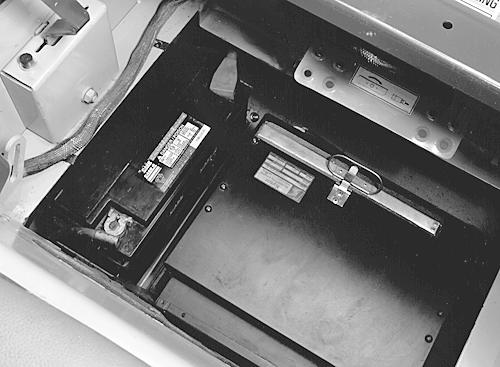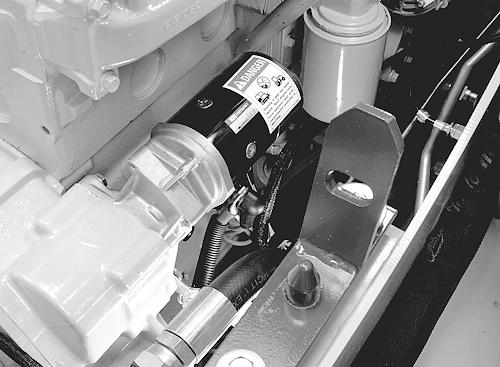
4 minute read
RUN-IN PERIOD
Engine
During the first 20 hours of operation for a new machine, or if the engine has been rebuilt, adhere to the following procedure: 1.Operate the machine with normal loads for the first 8 hours. Do not work the engine hard at stall speeds (wheels turning slow or stopped and engine speed at full throttle). 2.Keep the engine at normal operating temperatures. 3.Do not run the engine at idle speeds for long periods of time.
Wheel Nuts
If the machine is new or if a wheel is removed for service, check and tighten the wheel nuts tightness every two hours of operation until they remain tight. If the machine is equipped with stamped center wheels, the lug nuts will be tapered type lug nuts.Tighten each lug nut to a torque of 135 to 163 Nm (100 to 120 pound-feet). If the machine is equipped with solid center wheels, the lug nuts will be flange type lug nuts.Tighten each lug nut to a torque of 224 to 265 Nm (165 to 195 pound-feet).
Hydraulic Filter
Replace the hydraulic filter after 20 hours of use if a major hydraulic component has been replaced. See “Replacing the Hydraulic Filter” page 162.
Drive Chains
Adjust, if necessary the drive chains after 20 hours of operation if the drive chains have been replaced. See “Adjusting the Drive Chain Tension” page 172.
Preventing Damage to the Hydrostatic System in Cold Temperatures
IMPORTANT: Below 0°C (32°F), operate the engine at 1/2 throttle for 10 minutes with the controls in the NEUTRAL position. Do not operate the hydraulic cylinders rapidly or against the stops rapidly until the hydraulic oil is warm. Increase the engine speed to 3/4 throttle and move the control levers to 1/2 forward. Move the machine at no load for one minute.
Engine Speed
Running the engine at idle speed for long periods can cause low operating temperatures. A low operating temperature can cause the formation of acids and deposits in the engine oil. It is recommended you run the engine at full throttle when operating conditions permit. IMPORTANT: When you operate a backhoe, it is recommended that you run the engine at 1/4 throttle.
Parking the Machine and Stopping the Engine
1.Park on level ground whenever possible and lower the loader attachment to the ground. IMPORTANT: If you must temporarily park the machine on a hillside, put the front of the machine toward the bottom of the hill. Make sure the machine is behind an object that will not move. 2.If the engine has been working at full load, run the engine at idle speed for two or three minutes to cool the engine parts evenly. NOTE: Turning the engine off at higher than low idle rpm will damage the turbocharger. 3.Turn the key to the OFF position to stop the engine. 4.Remove the key, raise the seat bar, move the loader controls until locked and release the seat belt.
Always use the hand rails and steps when exiting the machine. NOTE: The parking brake is engaged automatically.
WARNING: Jumping on or off the machine can cause an injury. Always face the machine, use the hand rails and steps, and get on or off the machine slowly.
SA038
Booster Battery Connection
WARNING: Wrong jumper cable connections or shorting across the starter terminals can cause the machine to move suddenly out of control. You can be injured or killed. Use the correct method shown on this page to connect jumper cables to this machine. Failure to follow these instructions can cause injury or death.
SA005
You can jump start this machine at the battery or at the starter.
Jump Starting at the Starter
1.Lower the loader arms and attachment to the ground. 2.Tilt the cab forward using the
“Tilting the Operators
Compartment Forward” procedure. 3.If another machine is used for power, make sure the two machines are not touching. 4.Connect the positive (+) jumper cable to the battery terminal on the starter motor.
5.Connect the (-) jumper cable to the ground at the starter. 6.Use the key switch to start the engine and disconnect the negative (-) jumper cable first and the positive (+) jumper cable last.
Jump Starting at the Battery
1.Lower the loader arms and attachment to the ground. 2.Remove the floor plate to gain access to the battery. 3.If another machine is used for power, make sure the two machines are not touching. 4.Connect the positive (+) jumper cable to the positive (+) battery terminal.
5.Connect the negative (-) jumper cable to the machine frame.
6.Start the engine and disconnect the negative (-) jumper cable first and the positive (+) jumper cable last.
1
2 1

1.POSITIVE (+) JUMPER CABLE
CONNECTION
1.POSITIVE (+) JUMPER CABLE
CONNECTION 2.NEGATIVE (-) JUMPER CABLE
CONNECTION
BP97D006 BP98H004









